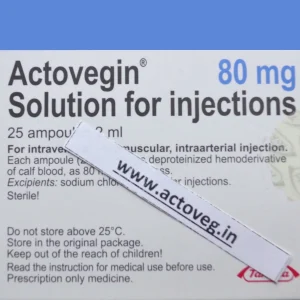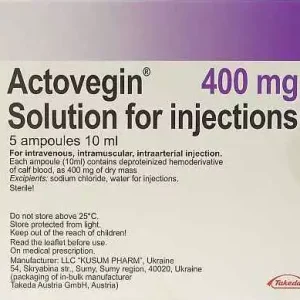Description
Actovegin 200 mg, (50 tablets)
Deproteinized hemoderivative of calf blood.
Dosage Form: coated tablets.
Formulation:
- 1 coated tablet contains:
Core: active ingredient: Blood components: deproteinized hemoderivative of calf blood – 200.0 mg
in the form of Actovegin powder* – 345.0 mg,
- excipients: magnesium stearate – 2.0 mg, talc – 3.0 mg;Shell:
- gum acacia – 6.8 mg,
- glycolic mineral wax – 0.1 mg,
- hypromellose phthalate – 29.45 mg,
- diethyl phthalate – 11.8 mg,
- aluminum quinoline yellow lacquer dye – 2.0 mg,
- macrо gol-6000 – 2.95 mg,
- povidon-K 30 – 1.54 mg,
- sucrose – 52.3 mg, talc – 42.2 mg,
- titanium dioxide – 0.86 mg.
*Actovegin powder contains: Active ingredient: blood components: deproteinized hemoderivative of calf blood – 200.0 mg, excipients: povidone-K 90 – 10.0 mg, microcrystalline cellulose – 135.0 mg.
Description:
Round bright coated biconvex tablets, with greenish-yellow tint.
Therapeutic Category:
Tissue regeneration stimulator.
Pharmacological Action:
Pharmacodynamic Properties
Actovegin is an antihypoxant with three primary effects: metabolic, neuroprotective, and microcirculatory.
It is known to increase the uptake and usage of oxygen and help to improve energy metabolism and reduce lactate formation in the presence of ischemia.
To achieve its neuroprotective effects, Actovegin blocks the development of apoptosis caused by beta-amyloid peptide (AP25-35), modulates the activity of the nuclear factor Kappa B (NF-kB), and inhibits the activity of the nuclear enzyme Poly-(ADP-ribose)-polymerase (PARP).
Additionally, its microcirculatory effects include increased capillary blood flow rate, decreased pericapillary space, lowered myogenic tone of precapillary arterioles and capillary sphincters, reduced arteri-venous shunt blood flow, and stimulation of the nitric oxide synthase of the endothelium.
Actovegin’s effects can be seen as early as 30 minutes after administration, with the maximal effect being seen 3 hours after parenteral and 2-6 hours after oral administration.
Pharmacokinetic Properties:
Using pharmacokinetic methods, it is not possible to study the pharmacokinetic parameters of Actovegin , since it consists only of physiologically active components that are usually present in the body.
Indications:
As part of comprehensive treatment:
- Symptomatic treatment of cognitive impairment, including post-stroke cognitive impairment and dementia.
- Symptomatic treatment of peripheral circulatory disorders and their consequences.
- Symptomatic treatment of diabetic polyneuropathy (DPN).
Contraindications:
- Hypersensitivity to Actovegin tablets and similar drugs or excipients.
- Fructose intolerance, glucose-galactose malabsorption or sucrase-isomaltase deficiency.
- Age under 18 years.
Use with Caution:
Pregnancy and breastfeeding period.
Use during Pregnancy and Breastfeeding:
Actovegin tablets should be used only in cases where potential benefit to the mother outweighs any potential risk to the fetus or the child.
Dosage and Administration:
For ingestion, it is recommended to swallow the tablets whole before eating, with a small amount of liquid to wash it down.
For post-stroke cognitive impairment, the recommended dosage is 2000 mg per day intravenously, by drop infusion for up to 20 infusions, switching to a tablet form of 2 tablets 3 times a day (1200 mg daily) for a total duration of 6 months.
For dementia, the recommended dosage is 2 tablets 3 times a day (1200 mg daily) for a total duration of 20 weeks.
For peripheral circulatory disorders and their consequences, the recommended dosage is 1-2 tablets 3 times a day (600 – 1200 mg daily) for a duration of 4 to 6 weeks.
For diabetic polyneuropathy, the recommended dosage is 2000 mg per day intravenously, by drop infusion for 20 infusions, switching to a tablet form of 3 tablets 3 times a day (1800 mg daily) for a total duration of 4 to 5 months.
Adverse Reactions:
The frequency of side effects has been determined in accordance with the classification of the Council for International Organizations of Medical Sciences (CIOMS): very often (≥ 1/10); often (≥ 1/100 to <1/10); infrequently (≥ 1/1000 to <1/100); rarely (≥ 1/10000 to <1/1000); very rarely (<1/10000); unknown (cannot be estimated according to the available data).
Immune disorders:
Rarely: allergic reactions (drug fever, shock symptoms).
Skin and subcutaneous tissue disorders
Rarely: urticaria, flush.
Overdose:
According to preclinical studies, Actovegin does not exhibit toxic effects even when the dose is exceeded by 30–40 times compared to the doses recommended for use in humans. There have been no cases of overdose with Actovegin .
Drug-to-Drug Interactions:
Currently unknown.
Special Warnings:
Clinical data
A multicenter, randomized, double-blind, placebo-controlled study known as ARTEMIDA (NCT01582854) was conducted to investigate the efficacy of Actovegin in alleviating cognitive impairment in 503 patients with ischemic stroke.
The incidence of serious adverse events and death was comparable between the treatment group and the placebo group.
The rate of recurrent ischemic strokes was consistent with the expected rate in this patient population, albeit with a higher number of cases in the Actovegin group compared to the placebo group; however, this difference was not statistically significant.
Effects on ability to drive and use machines:
None found.
Dosage Form:
200 mg coated tablets.
50 tablets in a tamper-evident bottle of dark glass with a screw neck, corked by aluminum caps.
1 bottle with the patient information leaflet is placed in a cardboard pack. Transparent protective tamper-evident round stickers with holographic inscriptions are glued onto the pack.
Manufactured and/or packaged at Takeda Pharmaceuticals (Japan):
50 tablets in a tamper-evident bottle of dark glass with a screw neck, corked by aluminum caps.
1 bottle with the patient information leaflet is placed in a cardboard pack. Transparent protective tamper-evident round stickers with holographic inscriptions are glued onto the pack.
Shelf Life:
3 years. Do not use after expiration date.
Storage:
Store in the dark place at a temperature not exceeding 25 °C.
Keep out of the reach of children!




